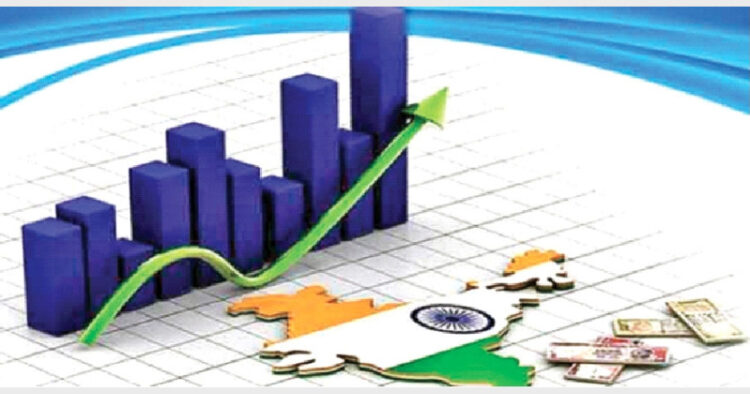The intervention made by the GST and demonetisation might have caused some hiccups but the current state of economy still outshines what it was during the UPA period
Shshank Saurav
The entire Opposition has been targeting the Modi- led NDA government after former finance minister Yashwant Sinha accused Arun Jaitley of the economic slowdown. There is no doubt that demonetisation and GST have worked as economic disruption with impact on the GDP numbers of the previous financial year as well as near-term forecast.
However, before we blame the economic policies of the NDA government and Jaitley for his decisions, it’s necessary to take a look at the economic performances of both NDA and UPA governments. If we compare the last year numbers of the UPA government vis-à-vis performance of the NDA government so far then undoubtedly Modi has fared better than his predecessor as the table below indicates clearly;
In order to have a holistic view of the economic performance of Manmohan Singh and Modi regime, one must set 2004 as starting point of discussion when the UPA came into power. There are a few major concerns which are raised to declare his government as failed on economic front and it’s necessary to look at them one by one-
- n Industrial slowdown- Modi launched his ambitious Make in India project in September 2014 and the aim was to develop India as a manufacturing hub along with job creation for masses. We have a natural advantage over others in terms of manpower and skill India project was launched to equip our human resource. There is a saying that Rome was not built in a day and same applies here also. We can’t build manufacturing capabilities in a day or two and it takes years to build the perception, infrastructure, favourable regulations etc. to attract the investors.
Manufacturing growth is linked with industrial production and the UPA inherited an industrial growth of 5.4% which came down to 4.2% when they left the office. Even today despite all hue and cry about the slowdown, it’s better than the UPA regime.
The GDP growth in 2004 was 8.2% which was driven by strong performance of manufacturing and agricultural sector. When the NDA led by Modi came to power in 2014, the growth was 6.9%. The most important part is the qualitative aspect of this growth which can be understood from the fact that YoY GDP growth was increasing when Manmohan Singh assumed the office but it was falling when Modi took the helm of affairs. In other words, the UPA’s job was easy because they had got a flourishing economy in legacy while what Modi got from Manmohan Singh was a sluggish economy along with policy paralysis and tainted image of the country due to syndicated loot during UPA regime.
If we keep the GDP and GVA mathematics aside and discuss an increase in per capita income which is another key parameter, then we will find that it has registered a CAGR of 8.69%. It doesn’t represent the increase in income of Ambanis, Adanis or Tatas alone but it shows that annual income of middle class and poor has also increased. - Bad loans and twin balance sheet issue- There is a decline in credit growth and private investment has come down. Investment is the important aspect in entire capital formation cycle which is effected by NPA mess. However, we must appreciate the fact that all the loans which have become bad were given in UPA regime and it was the job of the then government to review the profile and assess the creditworthiness of the borrowers. If the loans were given to politically powerful Jindal group or the lesser known Winson group without having a proper assessment of creditworthiness or without checking the utilization then how come Modi government be held responsible for misdeeds of Manmohan Singh regime.
This government has acted proactively by making suitable amendments to Banking Regulation Act, 1949; SARFAESI Act, 2002 and bringing Insolvency & Bankruptcy Code. Given the tainted background of UPA regime we can’t rule out the possibility of kickbacks in giving the loans otherwise it wouldn’t have happened that gross NPA is reaching double-digit as %ge of overall advances. - Expenditure on social schemes- Aim of the social schemes is to cater the needs of a marginalised section of the society and provide basic facilities to them. Track record of NDA government is far better than that of UPA on this front. Despite implementing the recommendations of 14th finance commission which required the central government to increase the share of state government in the annual budget, expenditure on social schemes is increasing on all the areas like education, health or employment guarantee scheme like MNREGA.
What the UPA left as a legacy was rising inflation, declining growth, a situation of policy paralysis, a tainted image due to mass loot and a tight fiscal situation. While figuring out the fiscal deficit, Chidambaram predicted a buoyancy in revenue collection which was never achieved and it left Jaitley in such a situation where there was little room left for him to increase the public expenditure. Growth has slowed down in the previous quarter but consumption hasn’t gone down and demand is still there in the market. There is one qualitative aspect which industry has to think and that is whether this demand is going to be fulfilled by import or indigenous goods. At times observers and analysts lose their objectivity due to some personal reasons. Modi bashers should understand that with every baseless argument and accusation they are just helping him in strengthening his position.
(The writer is a Chartered Accountant)














Comments